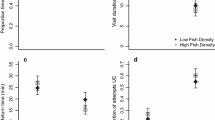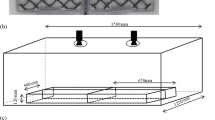Abstract
The apparently maladaptive tendency of fish to approach and inspect potential predators has been explained in terms of useful information gathering or as a signal to the predator that it has been seen. We examined this behaviour in 16 populations of wild-caught stickleback (Gasterosteus aculeatus) from ponds with and without predatory perch (Perca fluviatilis). Three large and three small individuals per population were each exposed to three model predators differing in realism. A final cooperative treatment entailed pairing subjects with a second individual from the same population, but of the alternative size class, during predator presentation. As might be expected, predator inspection behaviour was much greater in the predator-sympatric populations, and only these fish increased their level of inspection as the models became incrementally more realistic. This suggests that reductions occur in the level of costly inspection behaviour in populations without predators. Subject body size had no effect on inspection effort, which suggests a limited role for experience (we assumed larger fish to be older than smaller fish), at least over the relative age differences utilized. However, small predator-sympatric fish were the only subjects to increase inspection significantly when in a cooperative context, perhaps reflecting the inherent value of a relatively larger partner in this context. These results confirm that levels of predator inspection are both population- and situation-dependent, suggesting a trade-off in the potential costs and benefits of this behaviour.


Similar content being viewed by others
References
Conner RC (1996) Partner preferences in by-product mutualisms and the case of predator inspection in fish. Anim Behav 51:451–454
Csanyi V, Csizmadia G, Miklosi A (1989) Long-term memory and recognition of another fish in the paradise fish. Anim Behav 37:908–911
Dugatkin LA (1988) Do guppies play tit-for-tat during predator inspection visits? Behav Ecol Sociobiol 23:395–399
Dugatkin LA (1991) Predator inspection, tit-for-tat and shoaling: a comment on Masters and Waite. Anim Behav 41:898–899
Dugatkin LA (1997) The evolution of cooperation: four paths to the evolution and maintenance of cooperative behaviour. Bioscience 47:355–362
Dugatkin LA, Alfieri M (1991a) TIT FOR TAT in guppies: the relative nature of cooperation and defection during predator inspection. Evol Ecol 5:300–309
Dugatkin LA, Alfieri M (1991b) Guppies and the TIT FOR TAT strategy: preference based on past interaction. Behav Ecol Sociobiol 28:243–246
Eklöv P (1992) Group foraging versus solitary foraging efficiency in piscivorous predators: the perch, Perca fluviatilis, and pike, Esox lucius, patterns. Anim Behav 44:313–326
Fishmann MA (1999) Predator inspection: closer approach as a way to improve assessment of potential threats. J Theor Biol 196:225–235
Foster S, Ploch S (1990) Determinants of variation in antipredator behaviour of territorial male threespine sticklebacks in the wild. Ethology 84:281–294
Godin J-GJ, Crossman SL (1994) Hunger-dependant predator inspection and foraging in the threespine stickleback (Gasterosteus aculeatus) under predation risk. Behav Ecol Sociobiol 34:359–366
Godin J-GJ, Davis SA (1995a) Who dares, benefits: predator approach in the guppy (Poecilia reticulata) deters predator pursuit. Proc R Soc Lond B 259:193–200
Godin J-GJ, Davis SA (1995b) Boldness and predator deterrence: a reply to Milinski and Boltshauser. Proc R Soc Lond B 262:107–112
Godin J-GJ, Dugatkin LA (1996) Female mating preference for bold males in the guppy, Poecilia reticulata. Proc Natl Acad Sci USA 93:10262–10267
Huntingford FA, Coulter RM (1989) Habituation of predator inspection in the three-spined stickleback. J Fish Biol 35:153–154
Huntingford FA, Giles N (1987) Individual variation in antipredator responses in the three-spined stickleback (Gasterosteus aculeatus L.). Ethology 74:205–210
Huntingford FA, Wright PJ (1993) The development of adaptive variation in predator avoidance in freshwater fishes. Mar Behav Physiol 23:45–61
Huntingford FA, Lazarus J, Barrie BD, Webb S (1994) A dynamic analysis of cooperative predator inspection in sticklebacks. Anim Behav 47:413–423
Külling D, Milinski M (1992) Size dependent predation risk and partner quality in predator inspection of sticklebacks. Anim Behav 44:949–955
Licht T (1989) Discrimination between hungry and satiated predators: the response of guppies from high and low predation sites. Ethology 82:238–243
Magurran AE (1986) Predator inspection behaviour in minnow shoals: differences between populations and individuals. Behav Ecol Sociobiol 19:267–273
Magurran AE (1990) The inheritance and development of minnow antipredator behavior. Anim Behav 39:834–842
Magurran AE, Girling S (1986) Predator recognition and response habituation in shoaling minnows. Anim Behav 34:510–518
Magurran AE, Pitcher TJ (1987) Provenance shoal size and the sociobiology of predator evasion behaviour in minnow shoals. Proc R Soc Lond B 229:439–465
Magurran AE, Seghers B (1990) Population differences in predator recognition and attack cone avoidance in the guppy. Anim Behav 40:443–452
Magurran AE, Seghers BH, Carvalho GR, Shaw PW (1993) Evolution of adaptive variation in antipredator behaviour. Mar Behav Physiol 23:29–44
Milinski M (1987) Tit-for-tat in sticklebacks and the evolution of cooperation. Nature 325:433–437
Milinski M (1990a) On cooperation in sticklebacks. Anim Behav 40:1190–1191
Milinski M (1990b) No alternative to tit-for-tat cooperation in sticklebacks. Anim Behav 39:989–991
Milinski M (1992) Predator inspection: cooperation or ‘safety in numbers’? Anim Behav 43:679–680
Milinski M, Boltshauser P (1995) Fitness and predator deterrence: a critique of Godin and Davis. Proc R Soc Lond B 262:103–105
Milinski M, Külling D, Kettler R (1990a) Tit-for-tat: sticklebacks (Gasterosteus aculeatus) trusting a cooperative partner. Behav Ecol 1:7–11
Milinski M, Pfluger D, Külling D, Kettler R (1990b) Do sticklebacks cooperate repeatedly in reciprocal pairs? Behav Ecol Sociobiol 27:17–21
Milinski M, Luthi JH, Eggler R, Parker GA (1997) Cooperation under predation risk: experiments on costs and benefits. Proc R Soc Lond B 264:831–837
Pitcher TJ (1992) Who dares, wins: the function and evolution of predator inspection behaviour in shoaling fish. Neth J Zool 42:371–391
Pressley PH (1981) Parental effort and the evolution of nest-guarding tactics in the threespine stickleback, Gasterosteus aculeatus L. Evolution 35:282–295
Acknowledgements
We are grateful to Ashley Tweedale and Peter Wright for their help in the collection and care of the subjects, and to A.E. Magurran, N.B. Metcalfe and 3 anonymous referees for constructive comments on earlier versions of this manuscript. We would also like to thank the British Ecological Society who funded this project on a Small Ecological Projects Grant to C.W. (Ref: 131720). None of these experiments involved any licensed procedures and all experiments complied with the current laws of the United Kingdom.
Author information
Authors and Affiliations
Corresponding author
Additional information
Communicated by C. St. Mary
Rights and permissions
About this article
Cite this article
Walling, C.A., Dawnay, N., Kazem, A.J.N. et al. Predator inspection behaviour in three-spined sticklebacks (Gasterosteus aculeatus): body size, local predation pressure and cooperation. Behav Ecol Sociobiol 56, 164–170 (2004). https://doi.org/10.1007/s00265-004-0763-z
Received:
Revised:
Accepted:
Published:
Issue Date:
DOI: https://doi.org/10.1007/s00265-004-0763-z




